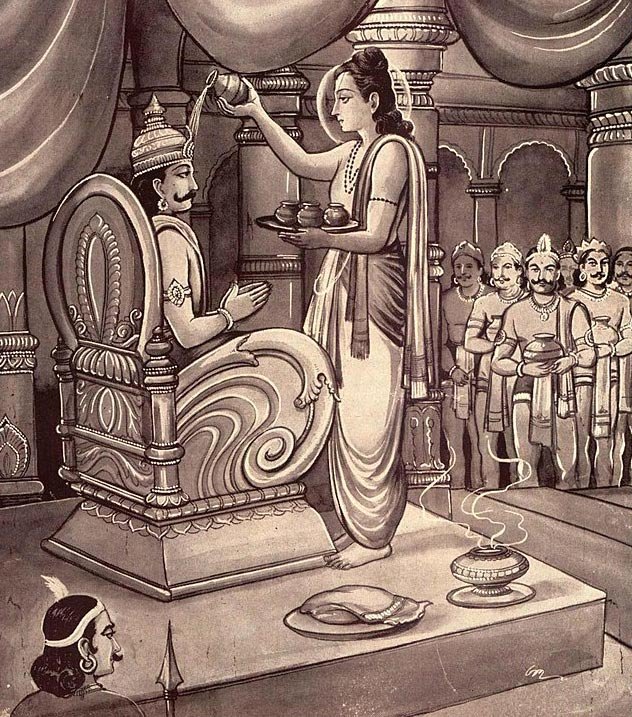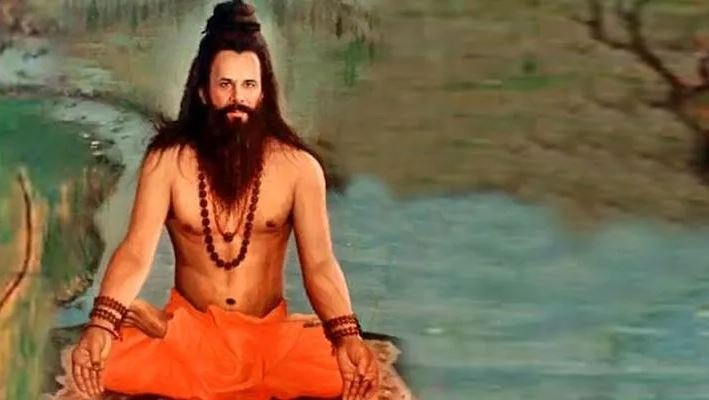Table of Contents
Introduction
In the fascinating realm of Hindu mythology, the notion of immortality isn’t just a flight of fancy but a profound element of spiritual narratives. Among the myriad of mythological figures, eight stand out as ‘Chiranjivis’ or ‘immortal beings’, believed to be alive even today. Their stories, interwoven with the fabric of Indian culture and spirituality, offer a window into the eternal.
Ashwatthama: The Warrior Cursed with Immortality

The saga of Ashwatthama, the son of Dronacharya, is marked by his prowess in warfare and a tragic curse that rendered him immortal. A central figure in the Mahabharata, Ashwatthama was cursed with eternal life and an incurable wound as a punishment for his deceitful massacre of the Pandavas’ sons. His story is often seen as a reflection on the consequences of moral transgressions and the perpetual burden of guilt.
Ashwatthama is considered as an avatar of one of the eleven Rudras. Along with his maternal uncle Kripa,Ashwatthama was a survivor of the Kurukshetra war. He was the son of Dronacharya and Kripi. Drona practicedsevere penance to appease Lord Shiva, since he wanted a son, who possesses the same valiance as Lord Shiva.He was blessed with a gem on his forehead. The night after Duryodhana’s defeat, a very disturbed and restless. Ashwatthama, had planned an attack on the Pandavas. Once he arrived at the Pandava camp, along with his army, they found a Bhairava blocking their entry. Ashwatthama strangled Dhrishtadyumna, the commander of the Pandava army, and the killer of his father Drona.
There are different versions of the story. In one version, Ashwatthama mistakes the sleepingUpapandavas for the Pandavas and kills them. In another version, he is known to have killed the Upapandavas, sincehe could not trace the Pandavas. The Pandavas and Krishna returned the next morning, to search for Ashwathama,who seeks refuge in Vyasa’s ashram. Ashwatthama invoked the deadly Brahmaastra, only to face anotherBrahmaastra from Arjuna. Ashwatthama asked the warriors to revoke the astras. Ashwatthama decided that if he could not kill the Pandavas, he would end their lineage, aiming the weapon at Uttara’s womb. Krishna revived the still born baby.Later, the infant was named ‘Parikshit’, which means the one who has been tested. Krishna asked Aswathhama, to surrender the gem on his forehead. He was cursed that the wound caused by removing the gem, on his forehead would not heal, and his body would suffer from a host of incurable diseases for over 3000 years.
King Mahabali: The Benevolent Monarch

King Mahabali’s tale is unique, portraying a demon king celebrated for his virtue. His reign was considered a golden era of prosperity and equality. However, due to a cunning request by Vamana, an avatar of Vishnu, he was sent to the netherworld. The legend goes that he was granted the boon to visit his subjects annually, an event celebrated as Onam in Kerala. This story exemplifies the virtues of humility, generosity, and the enduring bond between a ruler and his subjects.
Mahabali is the King of Asuras. He is the grandson of Prahlad and a descendant of sage Kashyap. Bali hadarranged Ashwamedha Yagna, to maintain his dominance over the three worlds. This created tension and insecurityin heaven and amongst the Gods. So, the Devas requested Lord Vishnu to help them. Vishnu manifested in hisVaman avatar and asked Bali, to grant him a piece of land to traverse three steps. As a result, Vaman traversed theearth and heaven in two steps. Bali offered his head and pushed Mahabali to Paatal Lok. Pleasedby Mahabali’s devotion, Vaman blessed Bali with the powers of Indra. Due to Bali’s selfless devotion and dharma, he was granted to pay a visit, to his land once each year. Thus, the Onam festival is celebrated every year in Kerala.
Vyasa: The Literary Titan

Vyasa, a sage with divine lineage, is revered as the compiler of the epic Mahabharata and the Puranas, and the arranger of the Vedas. His literary contributions are monumental, providing the foundation for much of Hindu philosophy and history. Vyasa’s life symbolizes the pursuit of knowledge and the importance of documenting wisdom and lore for future generations.
ed Vyas is also known as Krishna Dvaipayana. Around 5000 years ago, he was born in Damauli of Tanahi district in Nepal. His father was sage Parashar Rishi and his mother was Satyavati. He was the grandfather to Pandavas and Kauravas. He taught the Vedas to his pupils with immense devotion and dedication. It is said that Mahabharata is the 18th Purana that was written by Ved Vyas. It is believed that Ved Vyas requested Lord Ganesha to assist him in compiling the Mahabharata. However, Ganesha agreed on one condition. He stated that he would write the Mahabharata, only if Vyas narrates it without a single pause. To supersede this condition, Vyas put another condition and asked Ganesha to understand the verses, even before he had recited them. This is how the Mahabharata was written. Ved Vyas narrated the Upanishads and the 18 Puranas continuously to Lord Ganesha. He has been fondly mentioned in the Jataka tales too.
He fathered four famous sons, Pandu, Dhritarashtra, Vidur and Sukhdev. He received knowledge from great sages like Vasudev and Sanakadik. He described that the most important goal in one’s life is to attain Narayana or the Divine Supreme.
He compiled the Rigveda, Samaveda, Yajurveda and Atharvaveda. He was the first and greatest acharya of Sanatan Dharma. He is considered as a semi-incarnation of Lord Vishnu. It is believed that he reincarnated on earth in the Dwaparyuga to spread knowledge. Before his existence, Vedic knowledge only existed in the form of spoken words. He is referred to as Ved Vyas, because he had split the original version of Vedas into four parts. Ved Vyas literally means ‘the splitter of Vedas’. According to Mahabharat, Vyasa’s mother, Satyavati, was married to the king of Hastinapur. Shantanu bore two children, Chitrangada and Vichitravirya. After Shantanu’s death, she and her sons ruled the kingdom with the help of Bhishma. Although both her sons died childless, she arranged for her eldest son, Vyasa, to father the children of the two widows of Vichitravirya.
Hanuman: The Embodiment of Devotion and Strength

Lord Hanuman, a pivotal character in the Ramayana, is celebrated for his unwavering devotion to Lord Rama and extraordinary feats of strength. A deity in his own right, Hanuman’s tales are replete with acts of heroism, devotion, and humility. His life teaches the power of devotion and the strength that comes from unwavering faith.
Hanuman was born to Anjana and Kesari. While Hanuman’s mother was worshipping Shiva, king Dashrath ofAyodhya, performed the ritual of Putrakam yagna, since he desired to bear children. Dashrath was offeredkheer, which was shared by his three wives, leading to the birth of Ram, Lakshman, Bharat and Shatrughna. As thestory goes, through divine intervention, a kite snatched and delivered kheer to Anjana. Vayu, the wind God delivered the kheer to Anjana As a result, Hanuman was born. The Sundara Kanda in the Ramayan, focusses on Hanuman, who met Ram, after Ravan had kidnapped Sita. Hanuman helped them to defeat Ravan and rescue Sita.
Vibhishana: The Paragon of Dharma

Vibhishana’s story is one of righteousness and loyalty to dharma. Despite being born into the demon king Ravana’s family, he chose the path of righteousness, eventually aiding Lord Rama in the battle against his own brother. His life is a testament to the ideals of righteousness, loyalty, and moral integrity.
Vibhishana was a younger brother of Ravan. Though a Rakshas himself, Vibhishana was of a noble character. He wasagainst Sita’s abduction. Since his brother Ravan, did not heed his advice, Vibhishana joined Ram’s army. Later, whenRam defeated Ravan and crowned Vibhishana, as the king of Lanka. After Vibhishana became the King of Lanka, heturned his subjects from the path of evil, to the path of righteousness. Vishnu ordered Vibhishana to stay on earth,serve the people and guide them to the path of truth and righteousness. Vishnu, also asked Vibhishana to pray toLord Ranganatha, the family deity of Ram’s natal sun dynasty.
Kripacharya: The Sage of Timeless Wisdom

Kripacharya, the teacher of the Kuru princes, is renowned for his impartiality and deep wisdom. His life underscores the significance of education, the responsibilities of a teacher, and the enduring impact of imparting knowledge with equity and compassion.
Parashurama: The Warrior Sage with an Axe

Parashurama, an incarnation of Lord Vishnu, is depicted as a brahmin warrior carrying an axe, gifted by Shiva. His life is a series of confrontations against the tyranny of kshatriyas, symbolizing the eternal struggle against injustice and the restoration of dharma. Parashurama’s narrative is rich with themes of vengeance, redemption, and the complex interplay of power and morality.
Parshuram is a martial Shraman ascetic and an Avesha avatar. He was born at Renuka Tirth, as the sixth incarnationof Lord Vishnu. His father, Jamadagni, a great Saint Bhargva, was a direct descendant of Lord Brahma. It is said thatKartavirya Arjuna and his army forcibly took away Parshuram’s father’s magical cow named Kamdhenu. Parshuramkilled the entire army and king Kartavirya. To avenge the death of his father, Kartavirya’s son, killed Jamadagni, inParshuram’s absence. Parshuram was furious and killed all the sons of kings. He also conducted the Ashvamedha sacrifice, and gave away his entire holdings to the karmakandis, who conducted the ritual.
In the Mahabharata, Parshuram, was the Guru of the warrior Karna. Parshuram gave the Sudarshan chakra to Krishna. The main motto of Vishnu’s sixth incarnation was to free the earth’s burden, by assassinating the sinful andirreligious kings, who neglected their respective duties. As mentioned in the Kalki Purana, Parshuram still resides onearth. Parshuram is the martial guru of Kalki. He instructed Kalki, to perform a sacrament to appease Shiva, whoblessed Parshuram with celestial weaponry.
Markandeya: The Devotee Who Conquered Death

Sage Markandeya is celebrated for his unwavering devotion to Lord Shiva, which granted him immortality as a youth. His most famous tale involves his miraculous survival from Yama, the god of death, a feat achieved through his devotion. Markandeya’s life emphasizes the power of faith and the belief in divine grace.
Markandeya was a great devotee of Shiva. On the day of his death, he continued to worship theShivalingam. Yama, the ‘God of Death’, did not have the heart to take Markandeya’s life, because of his devotion forShiva. Yamraj, then came in person to take away Markandeya’s life, and sprung his noose around the young sage’sneck. The noose mistakenly landed around the Shivalingam. Shiva emerged in fury and attacked Yama. Later, Shivarevived Yama and blessed him with immortality. Hence, Shiva was known as Kalantaka, the ‘Destoyer of Death.’
WHERE ARE THE CHIRANJEEVI’S NOW IN KALYUGA?

Hanuman: It is believed that Lord Hanuman resides on the Gandmadan Mountain. There are physical traces of giant footprints, which prove Hanuman’s presence on earth, especially in Asia. He has mystical powers to take any form. It is believed that Lord Ram would assign him some important roles in next Kalpa. Common people, who are not pure as per Hindu culture, were kept away from Hanuman’s presence. It is believed that he was spotted by a pilgrim in Mansarovar in 1998.
Bali: According to Bhagvatam, Bali is presently in Paatal Lok. It is believed that he would be Indra in next Manvantar.
Parshuram- It is believed that he resides on the Mahendra Parvat near Vaishno Devi temple. He is summoned by Parshuram, in case of any complicated matter of Jivatma karma. He is not visible through the naked eyes.
Ashwatthama – He was spotted in Bihar, Uttar Pradesh and Gujarat. He was spotted by a pujari at Kanpur. He was about 10 feet tall and blood was oozing from his forehead. He visits the temple for Jal Abhishek ,every day around 4.30 a.m.
Ved Vyas: He was born in the last of Tretayug, lived through Dwaparyug, and also had seen the initial phase of Kalyug. He is considered as the avtar of Vishnu. He is present in Haridwar, Vrindavan and Chitrakut.
Vibhishan- He was spotted by Goswami Tulsi Das, around 500 years ago. At present, he is in Lanka. As instructed by Lord Ram, he often visits Lord Jagannath temple at Puri, Odisha , to revere his isht dev, Lord Ram. He was blessed as a Chiranjeevi, to maintain morality and righteousness in Lanka.
Kripacharya – He was the Kul Guru during the Mahabharat war. His status as a Chiranjeevi is disputed due to his impartiality towards his disciples. He is usually spotted in the Himalayas.
Markandeya- Markandeya resides near the Yamunotri shrine in the Uttarkashi district of Uttarakhand. The earliest version of Markandeya Purana was composed by Markandeya near the Narmada river, in Western India .
Conclusion
The stories of these eight immortals, woven into the fabric of Hindu mythology, transcend time and continue to resonate with profound spiritual messages. They serve not just as historical or religious narratives but as allegories for enduring human values such as righteousness, loyalty, knowledge, and devotion. These tales, blending the mystical with moral teachings, continue to inspire and guide individuals, reflecting the timeless quest for meaning, purpose, and understanding in the human journey.
In exploring the lives and legacies of these immortal beings, we step into a realm where myth and history intertwine, offering insights into not just the spiritual heritage of India but also the universal human condition. Their enduring presence reminds us of the immortality of virtue and the perpetual relevance of ancient wisdom in our modern world.

